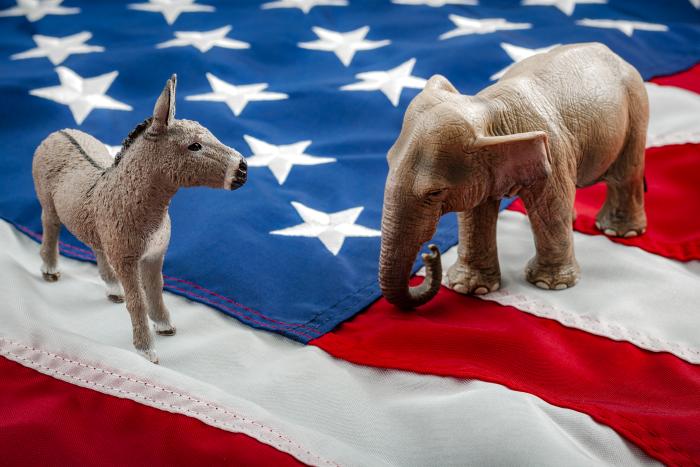- History
- Contemporary
- US
- Politics, Institutions, and Public Opinion
- Campaigns & Elections
Election Day is now less than four weeks away. Recent polls have put Democratic candidate Joe Biden in the lead, but we might remember that Hillary Clinton, too, was ahead at this point in 2016. One reasonably straightforward way to examine what could happen is to compare the two election seasons to see how those who voted for Donald Trump and Hillary Clinton in 2016 intend to vote this time around.
We know the 2016 vote totals, and by comparing them to YouGov/Economist online poll numbers from four years ago we can be reasonably sure that the polling is accurate. The election saw Clinton win by 2.1 percent of the popular vote; in the 2016 poll numbers used here, Clinton wins by 1.8 percent. Thus, comparing the 2016 and 2020 poll results gives us a good framework to assess the state of the race with a month to go. Table 1, drawn from YouGov polls in late September, compares voter choices nationwide in the two elections. Each column shows how members of a 2016 voter bloc would distribute their votes this year.

The polls show that Biden would get 88.5 percent of Clinton’s voters while Trump would get 83.1 percent of his previous voters, giving Biden an advantage. Biden would attract 4.1 percent of former Trump supporters while Trump would pick up 2.3 percent of Clinton’s voters. Those who went for Libertarian candidate Gary Johnson, Green Party candidate Jill Stein, or some other third-party contender in 2016 are backing Biden this year at 35.1 percent to Trump’s 10.9 percent.
In short, Biden in this national survey is doing better than Trump because he is holding more of Clinton’s voters; gaining more 2016 Trump voters than his rival is of Clinton voters; and winning over, at this point, more than three times as many of the 2016 third-party voters. As the table shows, this gives Biden a 7.6 percentage-point lead, which is comparable to the latest YouGov/Economist margin of 8 points and the RealClear Politics average of 8.3 (as of Oct. 4).
This comparison is useful because it shows candidates’ strengths and weaknesses, relative to the known 2016 results. Biden’s lead could weaken if Trump made gains, as he did in 2016 over the last weeks of the campaign, among third party voters and firmed up his support among those who voted for him the first time around. The bulk of 2020’s undecided voters are those who in 2016 voted for a third party candidate or waited till the end to decide how to vote; while Biden holds a lead here, more than 60 percent of such voters have not yet decided whom to support.
Election analysts and pollsters, whatever their party affiliation, do not believe that Trump will collect a majority of the votes in the general election. However, as we know from the 2016 campaign, that is not necessary for Trump to win. The Trump strategy is to duplicate 2016 by focusing on an Electoral College victory, which means winning a sizable majority of the battleground states. Table 2 repeats the previous analysis but includes only battleground states. Biden does better in these states, with those voting for Clinton giving him 91.7 percent—but remember, Trump won most of these states in 2016. Biden’s vote totals need to be higher in 2020 because the 2016 Clinton vote was lower. Unlike in the national results, in battleground states Biden stands to get fewer of Trump’s voters while Trump gets more of Clinton’s voters.

Moreover, the third-party vote was lower in the battleground states, so Biden’s 23-to-11 lead is not as meaningful as it is in the national averages. Trump’s 82 percent of his own earlier voters is low, but one expects as the race tightens many of these voters will come back to Trump as they did in 2016. Overall, in the battleground states Trump has cut his disadvantage of 7-plus points to about 4 percent, which makes these states still up for grabs.
Biden’s advantage in the battleground states is not as large as in national totals, but his support there seems firm. Of those voting for Clinton in 2016, only 5 percent have not committed, and in these states majorities of Democrats say they are voting against Trump. The president won’t be picking off any of these votes. Of the 15 percent of 2016 Trump voters who have not decided, women and moderate Republicans are overrepresented, and it is these voters who were with Trump in the previous election that the president will have to bring back into the fold if he is to win in the battleground states.
Over the next month, many continuing events may shift these results: the televised debates, the course of the coronavirus pandemic, including Trump’s illness, protests in Portland and elsewhere, and the fight to confirm Judge Amy Coney Barrett to the Supreme Court. One thing is clear: the election is still being fought in the battleground states.
















